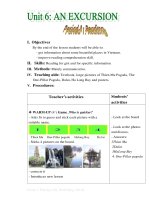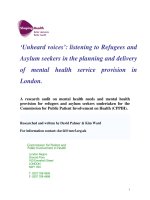Looking and Listening
Bạn đang xem bản rút gọn của tài liệu. Xem và tải ngay bản đầy đủ của tài liệu tại đây (98.9 KB, 12 trang )
19
CHAPTER
3
L
OOKING AND
L
ISTENING
The eyes have it—and so
do the ears. These are the
two most common study
styles. Is one of them your
strongest? Whether you
answer yes or no, you
probably use both
styles often. In this chapter,
you’ll learn how to make
the most of what you see
and what you hear.
I
n Chapter 2, you began to discover your
own learning styles by looking at what you like to do and what
comes to you easily. You looked at five different styles, and you
probably found that one or two of them are most important to you.
This chapter concentrates on two of those styles: using your eyes and
using your ears. Most people find that they rely heavily on one or the
other of these–even people who also rely on images, order, or doing to
help them learn.
Matching the Situation with Your Learning Style
Jonah and Mike are both studying Public Speaking. Jonah learns
better by hearing, and Mike learns better by seeing. When
responding to speeches by classmates, Jonah listens carefully, giv-
ing the speaker his full attention, and Mike tries to write as much
as he hears, underlining what’s important or interesting to him.
Mike also pays attention to visual aids, such the blackboard or
handouts. Both Jonah and Mike give similar responses to the
speaker, but they have to focus on the speech in very different
ways. If Jonah just wrote notes, and Mike just listened, they both
would have a problem understanding what the speech was
about.
HOW TO STUDY
20
EYES OR EARS
Few people actively use both their eyes and their ears in learning new
things. One or the other is usually much stronger. In this chapter, you’ll
continue to explore whether you are more a visual or an auditory learn-
er. Once you’ve done that, you’ll learn study tips that will help you take
advantage of your strength and help you learn to use the weaker learning
style. After all, you sometimes have to use a style that’s not your strongest.
If you’re listening to a tape or a lecture, you have to use your ears,
whether you’re an auditory learner or not. If you’re reading or making an
observation, your eyes play the lead role, whether you’re a visual learner
or not. So while you can learn to take advantage of your strong side, you
have to learn to use your weaker side as well.
In this chapter, you’ll find out how to make more of seeing and
hearing–both by using your own learning strength, and by finding ways
to work within a situation that doesn’t cater to your predominant style.
D
O
Y
OU
S
EE OR
H
EAR
B
ETTER
?
Imagine running into a friend you haven’t seen for a long time. The
friend is in a hurry to catch a bus. Neither one of you has paper or pen.
The friend tells you his phone number. What do you do to try to
remember the number?
Imagine you’re traveling by bus to a town you haven’t been to
before. You pass a billboard with important hotel and restaurant infor-
Find Out!
LOOKING AND LISTENING
21
mation. You don’t have paper and pen with you. What do you do to try
to remember what’s on the billboard?
Which exercise above came more naturally to you?
• Was it the phone exercise? If so, you probably learn better by hear-
ing.
• Was it the billboard exercise? Then you probably learn better by
seeing.
• Were the two exercises the same for you? Yes? Then you probably
learn better when you see and hear something at the same time.
B
OOST
Y
OUR
E
YE OR
E
AR
P
OWER
OK, now that you know whether you learn better with your ears or your
eyes, what do you do to study more effectively? Whether you’re summa-
rizing what you read, or reflecting on what happened in the last class, try
one of these techniques:
• Give yourself something to hear: speak! Take notes by speaking
into a tape recorder. You can play this back not only at your best
study time (see Chapter 1), but in a headset when you’re commut-
ing to or from work, when you’re on your lunch hour, doing dish-
es at home, or going for a walk.
• Give yourself something to see: write or draw! Carry a little note-
book or sketch pad around with you to write or draw after-
thoughts of what you studied. You can study not only at your best
time of day, but since you’re carrying your notes with you, when-
ever you have a few minutes–even in the bathtub.
BE ALL EARS
Here are ways to make the most of using your ears in studying, whether
they’re your learning strength or not.
W
HEN
L
ISTENING
Use only your ears. Try closing your eyes when you’re listening to some-
thing you want to remember, whether it’s a tape of a speech or notes
HOW TO STUDY
22
you taped into a recorder. Now your ears have to do all the work! Try
the same thing when you’re on the phone or listening to news on the
radio or TV. Closing your eyes can help your ears focus. You’re helping
your ears get the most out of what you hear by not letting what you see
get in the way.
Learning a New Language?
If you’re studying a language, the sooner your ear becomes familiar with
the sound and rhythms of that language, the easier it will be for you to
use that language, both in speaking and writing. Tune into the language
you’re learning by listening to radio talk shows and TV programs in that
language. Remember to close your eyes! You’re just using your ears. It’s
too easy for your eyes to figure out what’s happening on TV.
W
HEN
R
EADING
When you’re reading something you want to remember, try reading out
loud. Listen to your voice and change the sound of it when the mood of
what you’re reading changes. Have fun making deep and high sounds,
loud and soft sounds. Have you ever noticed in a play or movie, that just
before actors say something important, like, “The butler did it,” they
pause? There’s usually a pause after they say it as well. Decide what’s
important to you in what you’re reading, and try pausing before and after
you say that. Try it right now with this paragraph.
IT’S IN THE EYES
Here are ways to make the most of using your eyes in studying, whether
they’re your learning strength or not.
W
HEN
L
ISTENING
When you’re listening to something you want to remember, try drawing
a picture or taking notes. If you’re drawing, draw what comes to mind
right away. These are your notes, so they have to make sense to you! Stick
figures are fine. If you’re writing, pretend you’re a newspaper reporter
with a lot of readers. It’ll help you focus on what’s important, and your
notes will be clearer to you if you pretend you’re writing them for
someone else.
LOOKING AND LISTENING
23
W
HEN
R
EADING
When you’re reading something you want to remember, draw or write. If
you’re writing, try choosing the most important word in a sentence, then
the most important sentence in the paragraph. Underline it if it’s your
own book; if it’s not, write it in your notebook. Explain why it’s impor-
tant; summarize what you read in words. If you’re drawing, make a series
of pictures, just like in a comic strip, summarizing what sticks out in your
mind about what you read.
STRENGTHEN YOUR EYES AND EARS
Practice focusing on looking and listening when watching TV.
• Use your ears. Close your eyes. Talk (even to yourself!) about
what you heard.
• Use your eyes. Turn off the sound. Draw or write about what
you saw.
Write in your notebook about what using your ears and then your
eyes was like for you. Thinking back to what you heard or saw, what sticks
out in your mind? Which was easier, relying on your eyes or your ears?
What did you need to do in order to concentrate when using your
less-favored style? The answer to this question can help you build up
your eyes if you learn better by hearing, and build up your ears if you
learn better by seeing.
If seeing or hearing is a problem for you, fast-forward to Chapter
20, “Knowing When You Need Help.”
Try It!









